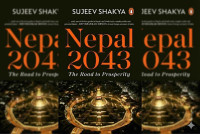Culture & Lifestyle
Trauma and healing beyond the stage
‘Content Advisory’, a play on gender-based violence, explores the real life stories of violence and harassment faced by students in and around a university campus.
Deepali Shrestha
Last Wednesday, as I sat on a bamboo stool right next to the stage to watch the housefull show of ‘Content Advisory’, a play staged during the Nepali International Theatre Festival, little did I know that I would partake in the breaking of the invisible wall between the audience and the stage. The actor performing on stage, a girl perhaps in her late teens, fixed her gaze on me, seated in front of the front row, realising that I was crying. Somebody from the audience passed me a bottle of water. The girl on stage started speaking in monologue, and shifted her gaze toward the entire audience even as tears rolled down her big, dark eyes. Now, I could clearly see myself in her, just as I had seen myself through her eyes before. In puffy eyes and ruddy cheeks, it was as if we had found ourselves in each other; as if we were bound together by the paradoxical emotions of relief and distress simultaneously–relieved because we were in solidarity with each other and distressed because our experiences of pain and suffering were universal.
‘Content Advisory’ is a forum theatre play based on the theme of gender-based violence. Devised and performed by the students of Azim Premji University, Bangalore, the play recounts the real-life stories of violence and harassment faced by students in and around the university campus.
The play began with its director Evan Hastings, in a Newa patterned daura suruwal, asking the audience to tell the person seated next to them about the time they stood up against injustice. As the audience members spoke to each other, some of them in murmurs and others in slightly higher pitches, there was considerable noise in the theatre, setting the tone for the acts that were to follow on stage and beyond for the next hour.
The act on stage begins in a university campus setting, where students are performing their daily activities. It is hard to follow exactly what one character is doing as a plethora of movements happening on stage poignantly encapsulates campus life. Without using a prop, the characters bring on stage the nitty-gritty of college life with gestures and body language. Familiar Bollywood songs such as ‘Masti ki pathshala’ from ‘Rang De Basanti’ add to the feel of college life. We can sense tension brewing on the campus-stage even before the characters start speaking.
When the characters start speaking, four college students are seen discussing a book. When a girl says she has read the book, her friend humiliates her, beginning what is going to be a series of conflicts. Misgendering, gaslighting, harassment, and stereotyping follow one after another, scarring the characters deeply. Every act in front of a curtain downstage is a mix of confusion, unrest and suffocation experienced by the student-characters. The students desperately seek help among each other and from the university administration, and the latter remains apathetic to the students’ woes or unsure about how to respond appropriately.
The story of victimhood and helplessness then shifts behind the curtain upstage, behind the central line, where shadow gestures lay bare the bruised hearts of the victims. It is only in the shadows that the real feelings of the victims find a place. A massive shadow of a cobweb reflected on the curtain symbolises their inability to find an exit from the impasse. The significance of the shadow play technique in ‘Content Advisory’ is that it tells the story in abstractions, considering how traumas such as gender-based violence can be emotionally overwhelming for the audience. Shadows, by virtue of them being abstractions of the corporeal, make the audience feel as if these are our own and help us reflect collectively on a common issue.
The director plays a major role in the forum theatre form of ‘Content Advisory’, coming on stage after the end of each scene and facilitating communication between the actors and the audience. Set in Augusto Boal’s ‘theatre of the oppressed’ method, the play allows the audience and the actors to influence and engage with each other. When the actors begin performing a different version of the scene they have just performed, the audience is allowed to say ‘Stop!’ and then come on stage to show how they would have acted differently to alter the circumstances in the scene. The questions raised by the director, and the audience’s involvement in doing the scenes differently the second time, make the audience view the issues critically and not just get overwhelmed by emotions.
After the traumatic events, the friends come together on stage and each repeat different words highlighted in the play. “Cu cu culture… No big deal, no big deal, the… they… Aiyooo!” They look like parrots in a cage repeating the same words. This scene is unlike any other in the play, so it stands out from the rest, representing the various suppressed and unresolved conflicts that echo in the air we breathe.
The play that begins with the director urging the audience to share their story of standing up against injustice ends with the director and the actors spreading out in the audience and asking about the possible solutions to these issues. Each and every part in between connects with the beginning and the end like the tuned strings of an instrument. At last, the director and the actors invite the audience to dance behind the curtains, their shadows visible to the rest of the audience. The shadows move as if they are liberated souls. At the end, the play stays true to its vision of creating a safe space to narrate stories of violence and discrimination and let go of our traumas.
Our society is saturated with such stories of oppression, sexual harassment, and gender violence. We all have our own unresolved traumas from childhood, workplaces, universities, and schools that are suppressed deep within us. The play is extremely relevant right now as the conflict between suppressing and unleashing these issues is more prevalent today, especially among young people. It encourages the viewers not just to empathise but think beyond empathy and look for the way out, even if it is complex. Even as the victims in the play raise their voices against injustice, they are unaware of the traumas they are inflicting on their own friends. This is reflective of the ironies we often live in our real lives, and the play has successfully captured that. The play ends without a definite ending, leaving the audience to come up with, or at least think about, their own endings and solutions.
Despite the play’s simple design, every scene is incredibly rich and vivid thanks to the passionate, energetic performances of the actors. Bearing a pleasant smile and the confidence of 12 years of experience in Shadow Liberation Forum Theatre, the director flawlessly facilitates the involvement of the audience, most of whom are otherwise unaware of Forum Theatre. The audience is left with thoughts and questions about the issues they might be facing in their own realities. The audience’s involvement in ‘Content Advisory’ gives a different dynamic to the play and takes the play beyond the confinement of the stage. The beauty of a theatre play is that you, as in the audience, have the power to influence it. Unlike a movie, when the audience is holding popcorn and feeling a cornucopia of emotions and there is no way the characters in it can witness that let alone respond to it, a play gives us the space to do just that. The actors in ‘Content Advisory’ react to the audience’s response, making the play seem like a beautiful interaction between two old friends who completely understand each other. One major quality of a successful play is its ability to show much more than what is showcased on stage, and 'Content Advisory' epitomises it.
Deepali Shrestha is a student of media studies at Kathmandu University.




 11.12°C Kathmandu
11.12°C Kathmandu.jpg)















